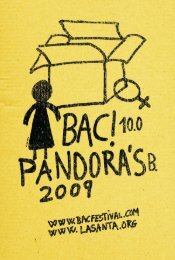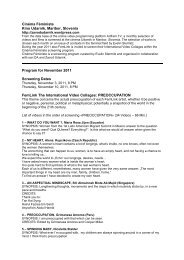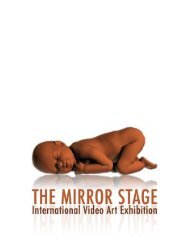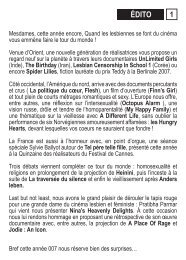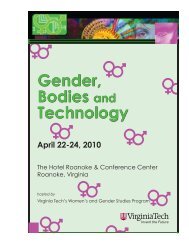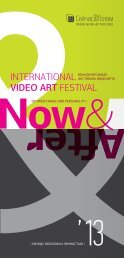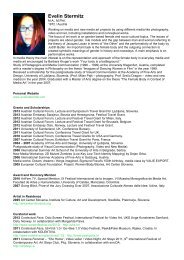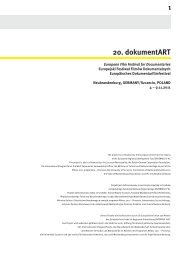Dones Indomables - evelin stermitz at her home
Dones Indomables - evelin stermitz at her home
Dones Indomables - evelin stermitz at her home
You also want an ePaper? Increase the reach of your titles
YUMPU automatically turns print PDFs into web optimized ePapers that Google loves.
YOKO ONO<br />
FREEDOM differs to CUT PIECE (1964), in which Ono points out the helplessness in front of social pressure to<br />
confront the stereotype of passive women. In FREEDOM, Ono takes off this stereotype by taking control of their<br />
nakedness, pulling <strong>her</strong> bra in an <strong>at</strong>tempt to free <strong>her</strong> breasts. The strength of the m<strong>at</strong>erial is an analogy for the<br />
struggle in the b<strong>at</strong>tle for emancip<strong>at</strong>ion in which women were involved in the early 70s. In <strong>her</strong> st<strong>at</strong>ement, reinforced<br />
by Lennon composition, Ono uses the bra as a symbol, emphasizing the importance of freeing women from social<br />
determin<strong>at</strong>ion and restrictive roles through the release of the body.<br />
FREEDOM és contraposa a CUT PIECE<br />
(1964), en la qual Ono externalitza la<br />
indefensió davant la pressió social<br />
que suposa enfrontar-se a l’estereotip<br />
de dona passiva. A FREEDOM, Ono<br />
s’allibera d’aquest estereotip i agafa<br />
el control de la seva nuesa, llençant<br />
el seu sostenidor, en un intent<br />
d’alliberar els seus pits, mostrant la<br />
resistència de la tela com a analogia<br />
de la dificult<strong>at</strong> que suposa la lluita<br />
per l’emancipació en què estaven<br />
involucrades les dones de començaments<br />
dels 70s. A la seva afirmació,<br />
reforçada amb l’ambientació de Lennon,<br />
Ono utilitza el sostenidor com a<br />
símbol, emf<strong>at</strong>itzant la importància<br />
d’alliberar la dona de la determinació<br />
social i els papers restrictius<br />
mitjançant l’alliberament del cos.<br />
1933<br />
FREEDOM<br />
60’’ · 1972<br />
FREEDOM se contrapone a CUT PIECE (1964), en la que Ono externaliza la indefensión ante la presión social de<br />
enfrentarse al estereotipo de mujer pasiva. En FREEDOM, Ono se despoja de este estereotipo, tomando control de su<br />
desnudez, tirando de su sujetador, en un intento de liberar sus pechos, mostrando la resistencia de la tela como<br />
analogía de la dificultad que supone la lucha por la emancipación en la que las mujeres estaban involucradas a<br />
comienzos de los 70s. En su afirmación, reforzada con la ambientación de Lennon, Ono utiliza el sostén como símbolo,<br />
enf<strong>at</strong>izando la importancia de liberar a la mujer de la determinación social y papeles restrictivos mediante la<br />
liberación del cuerpo.<br />
15



